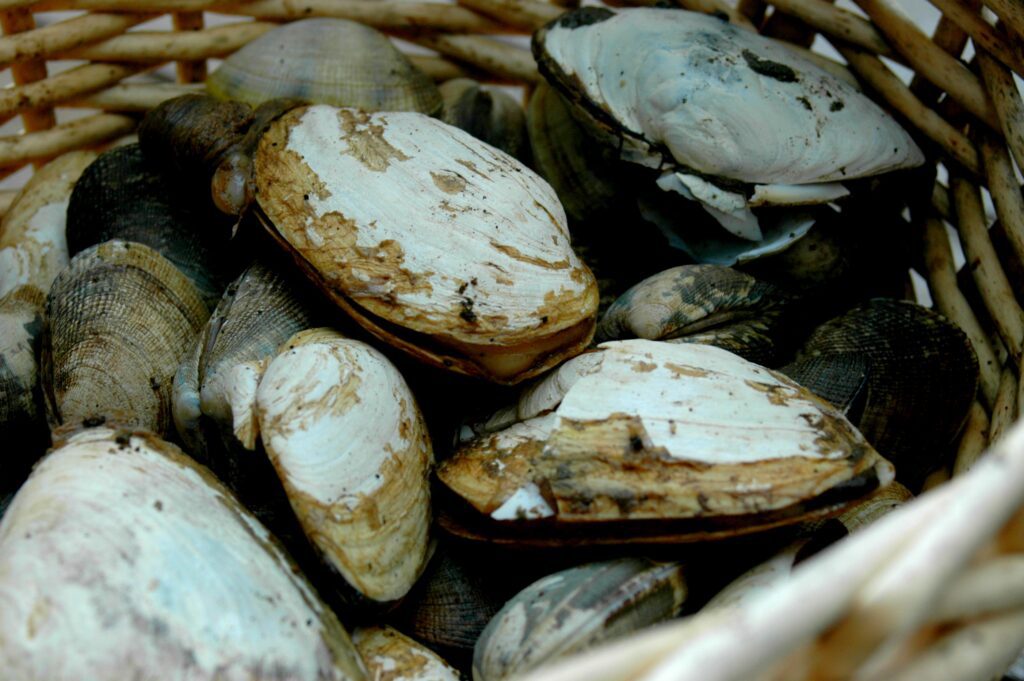Clamming Up

Whether you dig clams at a nearby public shoreline, or purchase live clams from a nearby retail store such as Taylor Shellfish, they are a local delicacy not to be missed.
Clams are quick and easy to prepare. Usually, ‘less is more’ to avoid overpowering the clams’ natural flavors.
Gathering, storing and cooking guidelines are described below.
Common Pacific Clams:
Pacific Littlenecks are small clams suitable for steaming.
Manila (Japanese) clams, introduced from Asia, are good steamed or raw.
Geoducks (pronounced gooey-ducks) are giant Pacific Northwest clams with siphons up to three feet.
Butter Clams, also native to the Pacific Northwest, are small clams enjoyed raw, steamed, or in stuffing.
Pacific Razor Clams are exceptionally meaty and excellent grilled or pan fried.

Most clams sold commercially have already been cleaned, but if you dig your own, you must remove the sand and grit from inside the shell before cooking.
Either use salt water or make enough saltwater brine (1 cup of salt per 3 quarts of water) to cover clams. Soak clams in salt water in the refrigerator several hours or overnight.
This is particularly important for clams with protruding siphons. For tightly closed hard-shell clams, it may be enough to simply scrub the shells to remove grit.
Another cleaning method uses cornmeal. Place clams in a sink or large pot of salt water (1/3 cup salt to one gallon of water) Add 1/4 – 1/2 cup cornmeal. The clams will naturally flush the sand in 1/2 – 1 hour.
Instead of pouring, PULL the clams out of the water to leave the sand and grit behind. Once purged, eat, cook or refrigerate. Fresh clams have a shelf life of 7-10 days from harvest.
Steaming:
Place cooking liquid (water, stock or wine) and seasoning (such as lemon, fresh herbs, sea salt, garlic, chile pepper) in a pot so that liquid comprises at least 2” in the bottom of the pot. Add cleaned clams in the shell. Bring water to a boil, reduce heat, cover and simmer until shells open (4 – 5 minutes). Discard any clams that don’t open. Serve clams in bowls along with the cooking broth, with a side of crusty French bread for soaking up the broth.
Grilling:
Place cleaned and scrubbed clams in the shell directly on to the grill, about 4 to 6 inches (10 to 15cm) above coals or heat source. Turn over with tongs after two minutes. Cook until shells open slightly, about four minutes.

Buying and Storing:
Live clams, collected or purchased, should be tightly shut or will close when tapped lightly on the shell. They should smell clean, like the ocean. The shells of most live clams are tightly closed. Some clams with protruding siphons cannot close completely when out of the water, but the siphon should pull in somewhat when touched.
Live clams in-the-shell will remain alive up to seven days in the refrigerator when stored between 38°F and 40°F in a container with slightly open lid. Drain excess liquid daily.
Clams can also be shucked and stored in an airtight container in the refrigerator for up to seven days. After cleaning, refrigerate clams in a bowl covered with a damp towel. Ideally, clams should be cooked as soon as possible.
If collecting live clams, be sure to know if there is a red tide on. Clams are filter feeders and are thus affected by this algal bloom. The following website lists the most updated beach closures due to any type of water condition (Agate Beach House is located in Mason County): http://ww4.doh.wa.gov/gis/mogifs/biotoxin.htm.
Other Clamming Guidelines:
Collect only from non-polluted waters. Harbours and near by industry can pollute clam beds
Know what local regulations there are for collecting both for number and size of clams. Washington State’s harvesting regulations can be found at the following link: http://wdfw.wa.gov/fishing/shellfish/statewide_rules.html.
Live clams are available year round, but they don’t stay fresh as long during the summer, when they are spawning.
Be aware if you have an allergy to shellfish. If in doubt, the first day try only one clam or a tiny particle. If no ill effects are seen in 24 hours, then it is usually safe to consume normal portions. People with liver problems should not eat large quantities of clams as they contain large amounts of copper.
